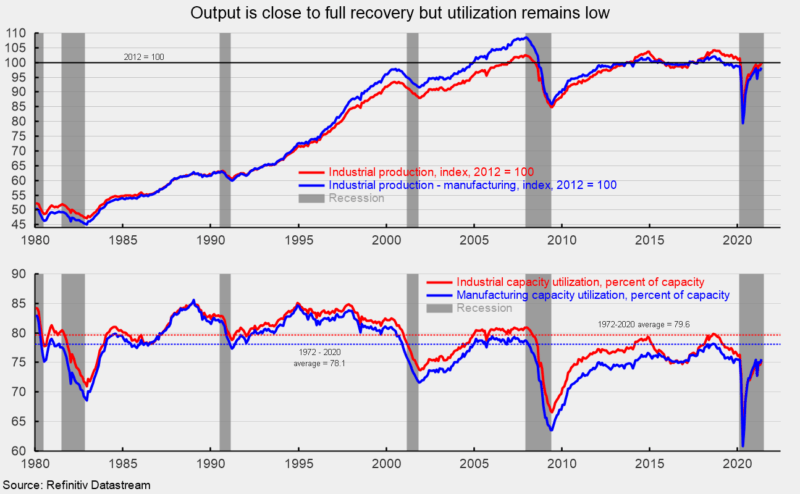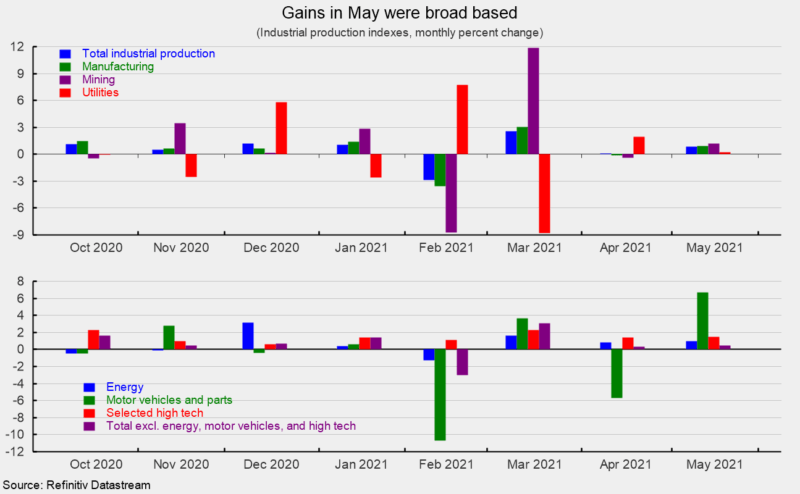Industrial Output Rose in May on Broad Gains; Capacity Utilization Remains Low
Industrial production rose 0.8 percent in May, the seventh gain in the last eight months. Manufacturing output, which accounts for about 75 percent of total industrial production, increased 0.9 percent, the sixth gain in the last eight months. Over the past year, total industrial output is up 16.3 percent while manufacturing output is up 18.3 percent. Both total industrial output and manufacturing output remain just slightly below their pre-pandemic levels (see top of first chart).
Mining output accounts for about 12 percent of total industrial output and posted a 1.2 percent increase in the latest month (see top of second chart). Over the last 12 months, mining output is up 16.5 percent.
Utility output, which is typically related to weather patterns, is also about 12 percent of total industrial output, and increased 0.2 percent for the month following a 1.9 percent increase in April (see top of second chart). From a year ago, utility output is up 3.6 percent.
Among the key segments of industrial output, energy production (about 25 percent of total output) gained 1.0 percent for the month (see bottom of second chart) and is up 11.0 percent from a year ago.
Motor-vehicle production (about 5 percent of total output), one of the hardest-hit industries during the lockdowns and now suffering through a semiconductor chip shortage, jumped 6.7 percent in May following a 5.7 percent drop in April (see bottom of second chart). Motor-vehicle production is up 140.8 percent compared with May 2020. Total vehicle assemblies rose to 9.85 million at a seasonally-adjusted annual rate. That consists of 9.58 million light vehicles and 0.27 million heavy trucks. Within light vehicles, light trucks were 8.00 million while cars were 1.58 million.
High-tech industries output rose 1.5 percent in May (see bottom of second chart) and is up 18.1 percent versus a year ago. High-tech industries account for just 2.2 percent of total industrial output.
All other industries combined (total excluding energy, high-tech, and motor vehicles; about 68 percent of total industrial output) gained 0.4 percent in May (see bottom of second chart) and are 13.3 percent above May 2020.
Total industrial utilization rose to 75.2 percent in May from 74.6 percent in April. That is still well below the long-term (1972-2020) average utilization of 79.6 percent (see bottom of first chart). Manufacturing utilization rose 0.7 percentage points to 75.6 percent, also still well below the long-term average of 78.2 percent (see bottom of first chart).
Industrial output posted a solid gain in May despite the ongoing difficulties with labor, logistics, and materials shortages. Many of these issues are likely to be resolved in the coming months and quarters, easing some of the upward pressure on prices. Substantial excess capacity is one reassuring factor in the outlook for prices. The likelihood of a 1970s-style inflationary spiral is relatively low given the vastly different structure of the economy today.







